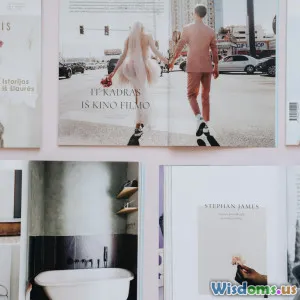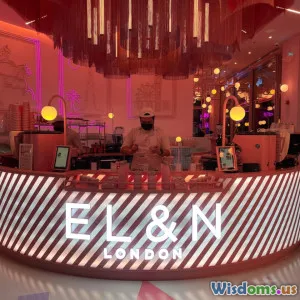
Using Color Psychology to Tell Powerful Visual Stories
7 min read Explore how color psychology shapes compelling visual narratives in graphic design to create emotional and memorable storytelling. (0 Reviews)
Using Color Psychology to Tell Powerful Visual Stories
Color is more than just a visual element in graphic design—it is a universal language that shapes perception, evokes emotions, and tells stories without words. Leveraging color psychology allows designers to craft visual narratives that resonate, influencing how people feel and interact with a design. In this comprehensive guide, we'll delve into how color psychology can be strategically used to create powerful visual stories that captivate and persuade.
Understanding Color Psychology: Beyond Aesthetic Appeal
Color psychology explores how hues impact human behavior and emotions. It is rooted in centuries of cultural associations and biological responses to light wavelengths. For example, red often triggers excitement or urgency, while blue instills calm and trust.
The Science Behind Colors
Neurologically, colors affect the limbic system, the brain's emotional center. When we see colors, our body releases hormones—red can increase adrenaline, while green might ease anxiety. Understanding this connection helps designers intentionally craft experiences that guide the audience’s emotional journey.
Example: Coca-Cola’s iconic use of red delivers energy and passion, which aligns with its brand personality of excitement and youthfulness.
Crafting Stories Through Color
Visual storytelling in design is not just about images; colors form the emotional backdrop that gives depth to narratives.
Setting the Mood
Colors establish mood instantly. Warm hues like oranges and reds can create urgency or warmth, while cool tones like blues and greens evoke relaxation or professionalism. Designers choose palettes based on the story’s emotional goals.
Case study: The UNICEF website predominantly uses shades of blue to convey trust, security, and calm—ideal for an organization focused on child welfare.
Symbolism and Cultural Relevance
Understanding cultural meanings of color is crucial. For instance, white signifies purity in Western cultures but symbolizes mourning in some Eastern traditions. Effective visual storytelling respects and adapts to such cultural contexts.
Color Harmony Tells Cohesive Tales
Combining colors harmoniously reinforces narrative flow. Complementary colors add vibrancy, while analogous colors create serene compositions. This harmony supports the coherence of the story presented.
Practical Techniques: Applying Color Psychology in Graphic Design
1. Define Your Narrative Goal
Start by pinpointing what the design should make the viewer feel or believe. Are you aiming for excitement, trust, nostalgia, or innovation?
2. Choose a Dominant Color with Intention
Select a primary color aligned with the desired emotional response. This color will guide the theme and tone.
3. Utilize Supporting Colors Strategically
Secondary and accent colors should enhance the story without overwhelming the core message.
4. Test for Accessibility and Inclusivity
Colors should remain effective and convey the intended message to color-blind users or those with different visual perceptions. Tools like ColorBrewer and Contrast Checker can help.
Example: Spotify's use of neon green against black creates a futuristic and energetic mood, appealing to a young and dynamic audience.
Industry Insights & Expert Opinions
Design experts emphasize that color must never be chosen arbitrarily. As Jennifer Cole Phillips, color expert and author of Blue is the New Black, notes, “Color in design must harmonize with your story and brand voice; otherwise, it risks disconnecting from the audience.”
Research by the Institute for Color Research found that up to 90% of quick judgments about products are based on color alone, underscoring the critical role color plays in storytelling and branding.
Measuring Impact: Case Studies
Airbnb’s Rebranding
Airbnb transitioned from a bright red to a softer, rosy coral that communicates warmth and inclusiveness, enhancing its visual story of belonging.
National Geographic
Its use of bold yellow symbolizes illumination and discovery, perfectly mirroring its mission to inspire and educate.
Conclusion: Harnessing Color to Tell Your Story
Color psychology is a dynamic tool in the arsenal of graphic designers seeking to tell impactful visual stories. Understanding the emotional and cultural language of colors enables creators to evoke specific feelings and guide viewer behavior subtly but effectively.
By thoughtfully selecting and combining colors, designers can bridge the gap between aesthetics and message, turning visuals into powerful stories that linger in the audience’s mind.
Embrace color psychology not just as a design function, but as an art form that animates your narratives with emotion and meaning.
References
- Labrecque, L. I., & Milne, G. R. (2013). To be or not to be different: Exploration of norms and benefits of color differentiation in the marketplace. Marketing Letters.
- Phillips, J.C. (2013). Blue is the New Black. Wiley.
- Institute for Color Research. (2019). Color and Consumer Behavior Report.
Start experimenting with color mindfully today—and tell your next visual story with power and precision!
Rate the Post
User Reviews
Popular Posts





















